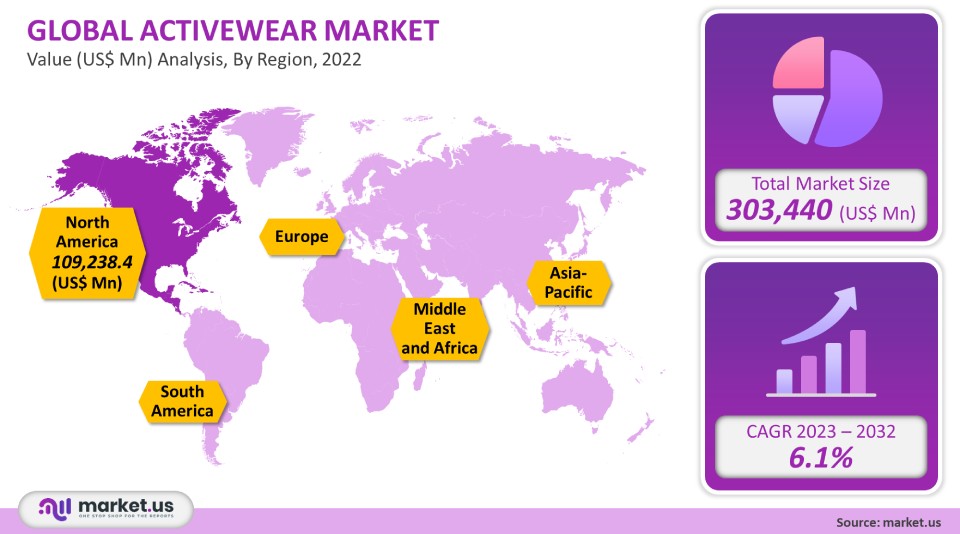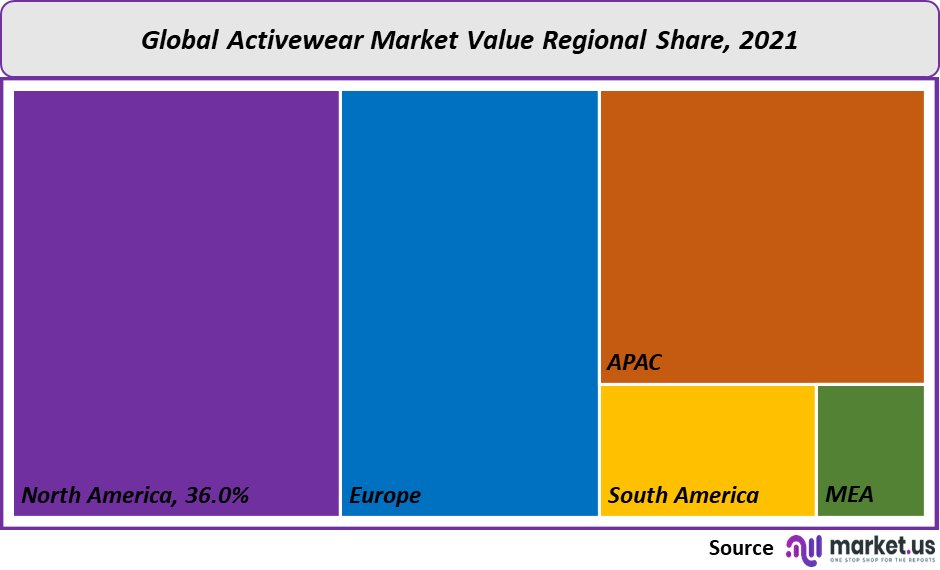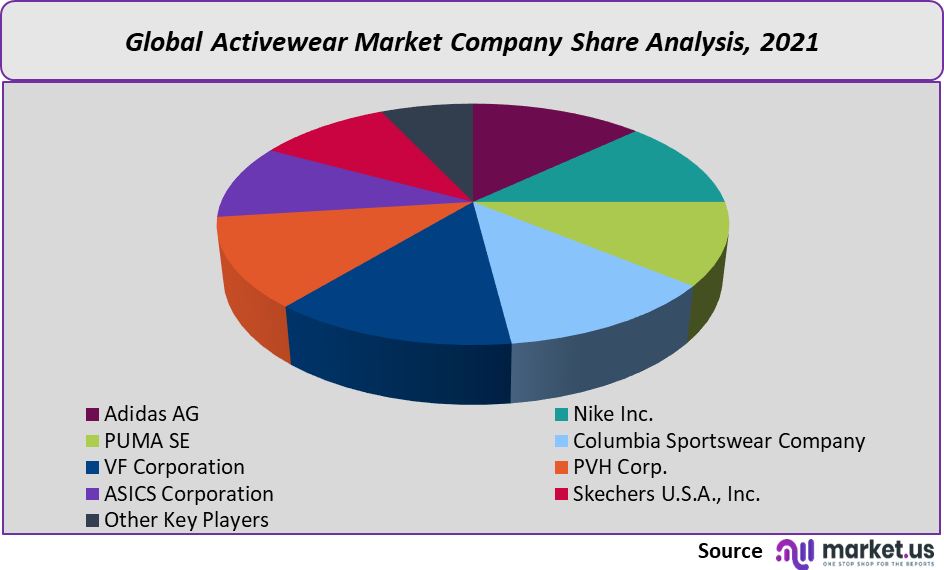Global Activewear Market, By Type(Men, Women, and Kids), By Application (In-store, and Online), By Region, and Key Companies - Industry Segment Outlook, Market Assessment, Competition Scenario, Trends and Forecast 2023-2033
- Published date: April 2023
- Report ID: 60532
- Number of Pages: 259
- Format:
- keyboard_arrow_up
Quick Navigation
Activewear Market Overview:
Global activewear market was worth USD 303,440 million in 2021. It is projected to grow at a CAGR of 6.1% between 2023 and 2032.
The global market’s growth is due to consumers’ increasing preference for modern clothing in the gym and in everyday life. Due to an increased awareness of their health and desire to be fit, consumers are more likely to incorporate fitness and sports into their daily lives. Market dynamics have changed in recent years due to increased participation. This has resulted in an increased demand for activewear and sports gear.
Activewear is a clothing type that is typically worn during physical activity. It includes clothing such as t-shirts, sweatpants, leggings, and running shoes. The purpose of activewear is to protect the wearer from the elements and help them feel comfortable while they are participating in physical activity. Athletic clothing is typically more flexible and light than typical formal wear. To help keep the wearer dry, activewear often includes moisture-wicking fabrics like Dri-FIT or a water-resistant coating. Athletic clothing can also be made with UV protection to avoid sunburn.
Global Activewear Market Scope:
End-User Analysis
With a market share of more than 60.0%, the women’s segment dominated global markets in 2021. This is due to women’s increasing preference for fashionable activewear. Activewear has many benefits, including breathability and rapid drying. They also resist heat, chemical resistance, heat resistance, static resistance, heat resistance, and resistance to chemicals. Women’s activewear is also in demand due to rising health consciousness among consumers and growing interest in sports and fitness by female customers.
Due to the growing popularity of soccer, basketball, and cricket, the men’s segment will grow at a 4.8% CAGR over the forecast period. Activewear sales are expected to grow due to the increased participation of men in sports activities. The market is expected to grow due to the significant global spending of men on activewear and sports clothing. The forecast period will significantly increase the market share for kids. This segment’s growth is mainly due to consumer spending. The market growth is also fueled by the increasing demand for products and organized retail in developing countries.

Distribution Channel Analysis
In-store sales accounted for 70% of the total revenue in 2021. The world’s largest manufacturer of active footwear and apparel sells its products through many retail outlets. Retail outlets have a wide range of brands and products to choose from. This will fuel market growth. These establishments also provide support to sales representatives, which helps with segment growth. Global market leaders also take important initiatives to increase their retail sales, such as personalizing the shopping experience and promoting in-store experiences.
The online segment will experience the highest CAGR of 7.2% during the forecast period. The rapid pace of life and the increasing number of internet-connected users can explain the growth of the online marketplace. Leading players also started selling products online after the introduction of COVID-19. To remain competitive, they have adopted e-commerce strategies. Online portals offer quick refund and exchange options, helping grow the segment.
Key Market Segments:
By End-User
- Men
- Women
- Kids
By Distribution Channel
- In-store
- Online
Market Dynamics:
The COVID-19 pandemic severely affected the global activewear market in 2020. Many people have felt forced to stay inside and complete their daily tasks from home. Both outdoor and indoor activities have seen a rise in popularity. The cancellations or postponements of major athletic events caused major indoor and team sports problems. Different organizations launched campaigns encouraging people to exercise at home during the lockdown period. Consumers also needed new fitness clothes daily. This increased the demand for activewear and sportswear clothing.
The global market’s growth is due to the growing interest in sports and exercise by the younger generation. Synthetic fibers are also more flexible, durable, and washable, so items like spandex are easier to use, wash, and maintain than natural fibers. This market is also being driven forward by celebrity partnerships with DTC, designer sportswear businesses, and the blurring of the lines between work and exercise gear. Sportswear is seeing growth in various sectors, including modest and adaptable clothing, maternity activewear, and sustainable activewear.
The market will be driven by women’s increased participation in professional and domestic sports and other fitness activities over the forecast period. Trendy sports clothing is expected to increase women’s interest and contribute to market growth. The main factors driving market growth in developed countries are increasing disposable income, rising living standards, and lower production costs. The rise in counterfeit products is threatening consumer safety and quality problems and causing brand damage for key industry players.
Activewear clothing evolved from humble beginnings as sweaty workout clothes to cult-like popularity. Sweatshirts, hoodies, and polo shirts are staples in modern life and can be used for many purposes. Activewear that is fashionable and versatile is highly in demand. It is functional, stylish, adaptable, and can be worn at various events. Market leaders have capitalized on this trend by creating new, technically sophisticated products that are both practical and comfortable products to meet the growing demand.
People have been more likely to stay fit at home over the past few years. For a healthy lifestyle, clothing should be appropriate for every occasion. As a result, women’s clothing was one of many new options. Activewear is now more in demand. As sustainability has become a more pressing concern for consumers, companies have increased their product offerings. This trend is expected to continue, driving significant market growth and sales.
Regional Analysis:
North America accounted for the highest revenue share, at 36%, in 2021. This is mainly due to the rising popularity of activewear. The market is being driven by the presence of major industry competitors like Nike and Adidas. These companies hold a significant share of the North American market in terms of sales. Market expansion is expected to be driven by the popularity of soccer and basketball and increased health awareness. The main reasons for the regional market’s growth are rising disposable income, improved living standards, and lower manufacturing costs.
Asia Pacific will grow at the highest CAGR of 8.1% between 2023 and 2032. This market growth is supported by the growing demand for fashionable and attractive sportswear and gym equipment among young millennials. Most of the regional market is driven by countries with a higher proportion of young people, like India and China. Activewear will be more popular due to rising disposable income, increasing demand from international brands, and increased demand for activewear. The government programs encouraging active participation in sports and competitions will continue to drive the region’s market.

Key Regions and Countries covered in the report:
- North America
- US
- Canada
- Mexico
- Europe
- Germany
- UK
- France
- Italy
- Russia
- Spain
- Rest of Europe
- APAC
- China
- Japan
- South Korea
- India
- Rest of Asia-Pacific
- South America
- Brazil
- Argentina
- Rest of South America
- MEA
- GCC
- South Africa
- Israel
- Rest of MEA
To develop trendy activewear, businesses use strategic partnerships and mergers and acquisitions to gain an edge over their competition. Adidas, for example, launched Formotion in February 2021. This new sportswear line is designed to fit and support women of all sizes. All women who are looking for high-performance, comfortable activewear to wear while exercising, such as Pilates or HIIT, will find it in the newly launched Activewear line. The following are some of the significant players in activewear markets worldwide.

Market Key Players:
- Adidas AG
- Nike Inc.
- PUMA SE
- Columbia Sportswear Company
- VF Corporation
- PVH Corp.
- ASICS Corporation
- Skechers U.S.A., Inc.
- Under Armour, Inc.
- Hanesbrands Inc.
- Other Key Players
For the Activewear Market research study, the following years have been considered to estimate the market size:
Attribute Report Details Historical Years
2016-2020
Base Year
2021
Estimated Year
2022
Short Term Projection Year
2028
Projected Year
2023
Long Term Projection Year
2032
Report Coverage
Competitive Landscape, Revenue analysis, Company Share Analysis, Manufacturers Analysis, Volume by Manufacturers, Key Segments, Key company analysis, Market Trends, Distribution Channel, Market Dynamics, COVID-19 Impact Analysis, strategy for existing players to grab maximum market share, and more.
Regional Scope
North America, Europe, Asia-Pacific, South America, Middle East & Africa
Country Scope
United States, Canada and Mexico, Germany, France, UK, Russia and Italy, China, Japan, Korea, India and Southeast Asia, Brazil, Argentina, Colombia etc.Saudi Arabia, UAE, Egypt, Nigeria and South Africa
Frequently Asked Questions (FAQ)
Q: What is the size of the activewear market in 2021?The Activewear market size will be US$ 303,440 million in 2021.
Q: What is the projected CAGR at which the activewear market is expected to grow at?The Activewear market is expected to grow at a CAGR of 6.1% (2023-2032).
Q: List the segments encompassed in this report on the activewear market?Market.US has segmented the activewear market by geographic (North America, Europe, APAC, South America, and Middle East and Africa). By end-user, the market has been segmented into men, women, and kids; by distribution channel, the market has been segmented into in-store and online.
Q: List the key industry players in the activewear market.Adidas AG, Nike Inc., Puma SE, Columbia Sportswear Company, VF Corporation, PVH Corp., ASICS Corporation, Skechers U.S.A. Inc., and Other Key Players are leading key vendors in the Activewear market.
Q: Which region is more appealing for vendors employed in the activewear market?North America accounted for the highest revenue share of 36%. Therefore, the Activewear industry in North America is expected to garner significant business opportunities over the forecast period.
Q: Name the key areas of business for the activewear market.The US, Mexico, Canada, Germany, France, UK, China, Japan, etc., are key areas of operation for the activewear market.
Q: Which segment accounts for the greatest market share in the activewear industry?With respect to the activewear industry, vendors can expect to leverage greater prospective business opportunities through the women segment, as this area of interest accounts for the largest market share.

- Adidas AG
- Nike Inc.
- PUMA SE
- Columbia Sportswear Company
- VF Corporation
- PVH Corp.
- ASICS Corporation
- Skechers U.S.A., Inc.
- Under Armour, Inc. Company Profile
- Hanesbrands Inc. Company Profile
- Other Key Players
- settingsSettings
Our Clients
| Single User $4,599 $3,499 USD / per unit save 24% | Multi User $5,999 $4,299 USD / per unit save 28% | Corporate User $7,299 $4,999 USD / per unit save 32% | |
|---|---|---|---|
| e-Access | |||
| Report Library Access | |||
| Data Set (Excel) | |||
| Company Profile Library Access | |||
| Interactive Dashboard | |||
| Free Custumization | No | up to 10 hrs work | up to 30 hrs work |
| Accessibility | 1 User | 2-5 User | Unlimited |
| Analyst Support | up to 20 hrs | up to 40 hrs | up to 50 hrs |
| Benefit | Up to 20% off on next purchase | Up to 25% off on next purchase | Up to 30% off on next purchase |
| Buy Now ($ 3,499) | Buy Now ($ 4,299) | Buy Now ($ 4,999) |











